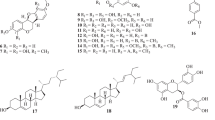Abstract
In this phytochemical study, 5 xanthones, 1,3,5,6-tetrahydroxyxanthone [1], 1,5,6-trihydroxy-3-methoxyxanthone [2], ferrxanthone [3], brasilixanthone B [4], and neolancerin [5] were isolated from adventitious roots of St. John’s wort (Hypericum perforatum L.). Compound 1–5 were evaluated for antioxidant activities using the intracellular reactive oxygen species (ROS) radical scavenging 2′,7′-dichlorfluorescein-diacetate (DCFDA) assay and for cytotoxic activity against the HL-60 human promyelocytic leukemia cells. Among them, compound 1–4 exhibited scavenging activity with inhibition values of 27.4–33.2% at 10 μM; compound 1, 2, and 4 reduced the viability of HL-60 cells significantly, with IC50 values of 31.5, 28.9, and 27.7 μM, respectively.
Similar content being viewed by others
References
Barnes J, Anderson LA, Phillipson JD. St John’s wort (Hypericum perforatum L.): A review of its chemistry, pharmacology and clinical properties. J. Pharm. Pharmacol. 53: 583–600 (2001)
Butterweck V, Jürgenliemk G, Nahrstedt A, Winterhoff H. Flavonoids from Hypericum perforatum show antidepressant activity in the forcedswimming test. Planta Med. 66: 3–6 (2000)
Sakar MK, Tamer AU. Antimicrobial activity of different extracts from some Hypericum species. Fitoterapia 61: 464–466 (1990)
Zou Y, Lu Y, Wei D. Antioxidant activity of a flavonoid-rich extract of Hypericum perforatum L. in vitro. J. Agr. Food Chem. 52: 5032–5039 (2004)
Maisenbacher P, Kovar KA. Adhyperforin: A homolog of hyperforin from Hypericum perforatum. Planta Med. 58: 291–293 (1992)
Orth HCJ, Rentel C, Schmidt PC. Isolation, purity analysis, and stability of hyperforin as a standard material from Hypericum perforatum L. J. Pharm. Pharmacol. 51: 193–200 (1999)
Tatsis EC, Boeren S, Exarchou V, Troganis AN, Vervoort J, Gerothanassis IP. Identification of the major constituents of Hypericum perforatum by LC/SPE/NMR and/or LC/MS. Phytochemistry 68: 383–393 (2007)
Rosenkranz AR, Schmaldienst S, Stuhlmeier KM, Chen W, Knapp W, Zlabinger GJ. A microplate assay for the detectionof oxidative products using 2′,7′-dichlorofluorescin-diacetate. J. Immunol. Methods 156: 39–45 (1992)
Cui XH, Murthy HN, Jin YX, Yim YH, Kim JY, Paek KY. Production of adventitious root biomass and secondary metabolites of Hypericum perforatum L. in a balloon type airlift reactor. Bioresource Technol. 102: 10072–10079 (2011)
Hwang BY, Kim HS, Lee JH, Hong YS, Ro JS, Lee KS, Lee JJ. Antioxidant benzoylated flavan-3-ol glycoside from Celastrusor biculatus. J. Nat. Prod. 64: 82–84 (2001)
Nielsen H, Arends P. Xanthone constituents of Hypericum androsaemum L. J. Nat. Prod. 42: 303–306 (1979)
Walia S, Mukerjee SK. Ferrxanthone, a 1,3,5,6-tetraoxygenated xanthone from Mesuaferrea. Phytochemistry 23: 1816–1817 (1984)
Marques VL, de Oliveira FM, Conserva LM, Brito RG, Guilhon GM. Dichromenoxanthones from Tovomita brasiliensis. Phytochemistry 55: 815–818 (2000)
Schaufelberger D, Hostettmann K. Chemistry and pharmacology of Gentiana lactea. Planta Med. 54: 219–221 (1988)
Fotie J, Bohle DS. Pharmacological and biological activities of xanthones. Antiinfect. Agents Med. Chem. 5: 15–31 (2006)
Boonsri S, Karalai C, Ponglimanont C, Kanjana-opas A, Chantrapromma K. Antibacterial and cytotoxic xanthones from the roots of Cratoxylum formosum. Phytochemistry 67: 723–727 (2006)
Suksamrarn S, Komutiban O, Ratananukul P, Chimnoi N, Lartpornmatulee N, Suksamrarn A. Cytotoxic prenylated xanthones from the young fruit of Garcinia mangostana. Chem. Pharm. Bull. 54: 301–305 (2006)
Yimdjo MC, Azebaze AG, Nkengfack AE, Meyer AM, Bodo B, Fomum ZT. Antimicrobial and cytotoxic agents from Calophyllum inophyllum. Phytochemistry 65: 2789–2795 (2004)
Author information
Authors and Affiliations
Corresponding author
Rights and permissions
About this article
Cite this article
Li, W., Sun, Y.N., Yan, X.T. et al. Isolation of xanthones from adventitious roots of St. John’s Wort (Hypericum perforatum L.) and their antioxidant and cytotoxic activities. Food Sci Biotechnol 22, 945–949 (2013). https://doi.org/10.1007/s10068-013-0168-8
Received:
Revised:
Accepted:
Published:
Issue Date:
DOI: https://doi.org/10.1007/s10068-013-0168-8




